Motivation Theories: Application & Impact in Modern Organizations
VerifiedAdded on 2023/06/12
|10
|3123
|342
Essay
AI Summary
This essay discusses the relevance of various motivation theories, including Maslow's Hierarchy of Needs, Alderfer's ERG theory, and McClelland's theory, in modern work organizations. It examines the applicability of these theories, highlighting their strengths and limitations with organizational examples like Tesco. The essay explains how motivation theories help improve employee efficiency, build healthy relationships, and increase overall productivity. It delves into intrinsic and extrinsic motivational factors and provides a critical analysis of each theory's effectiveness in contemporary business environments. It also considers the challenges in empirically testing some theories and matching employee needs effectively.
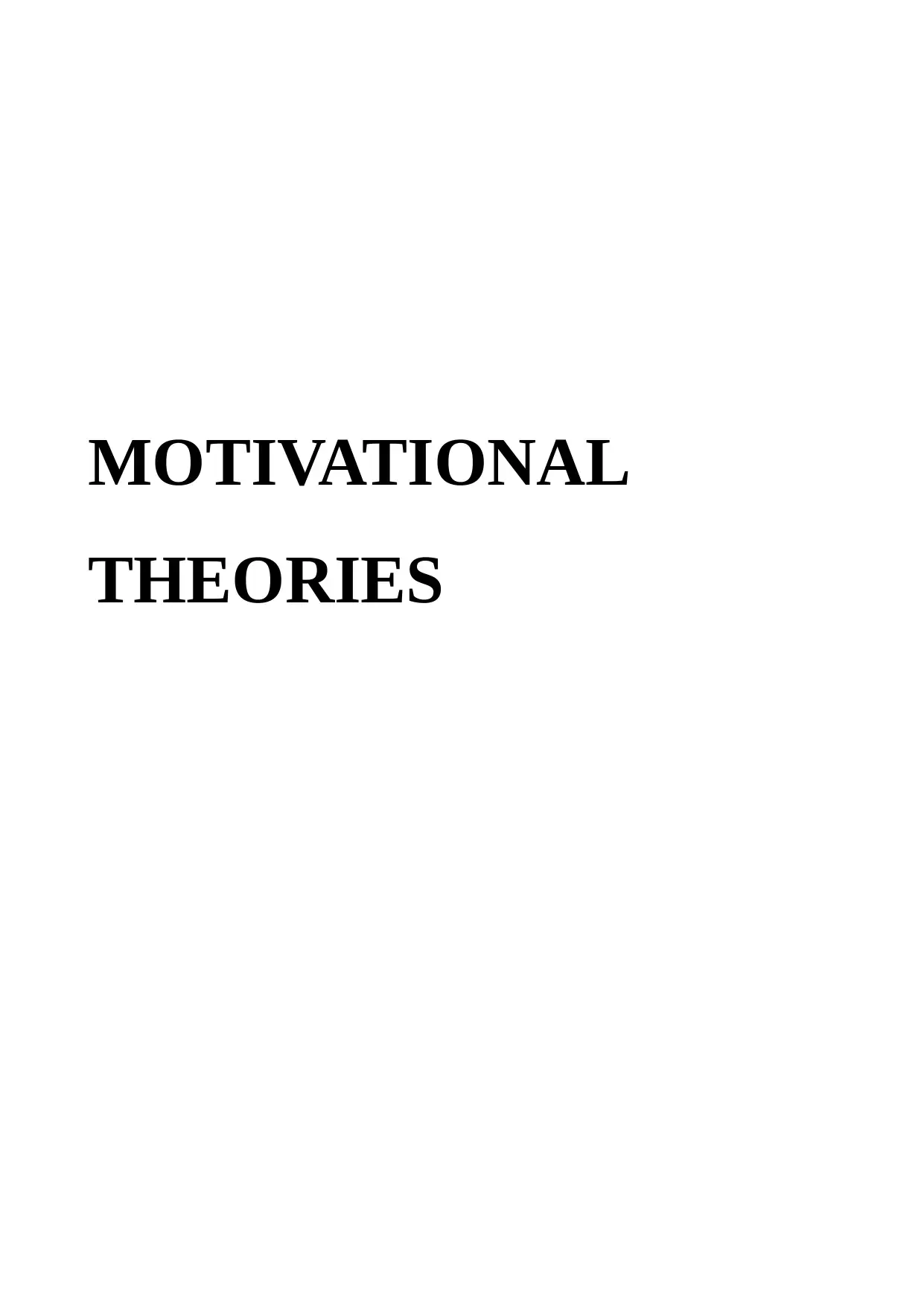
MOTIVATIONAL
THEORIES
THEORIES
Paraphrase This Document
Need a fresh take? Get an instant paraphrase of this document with our AI Paraphraser
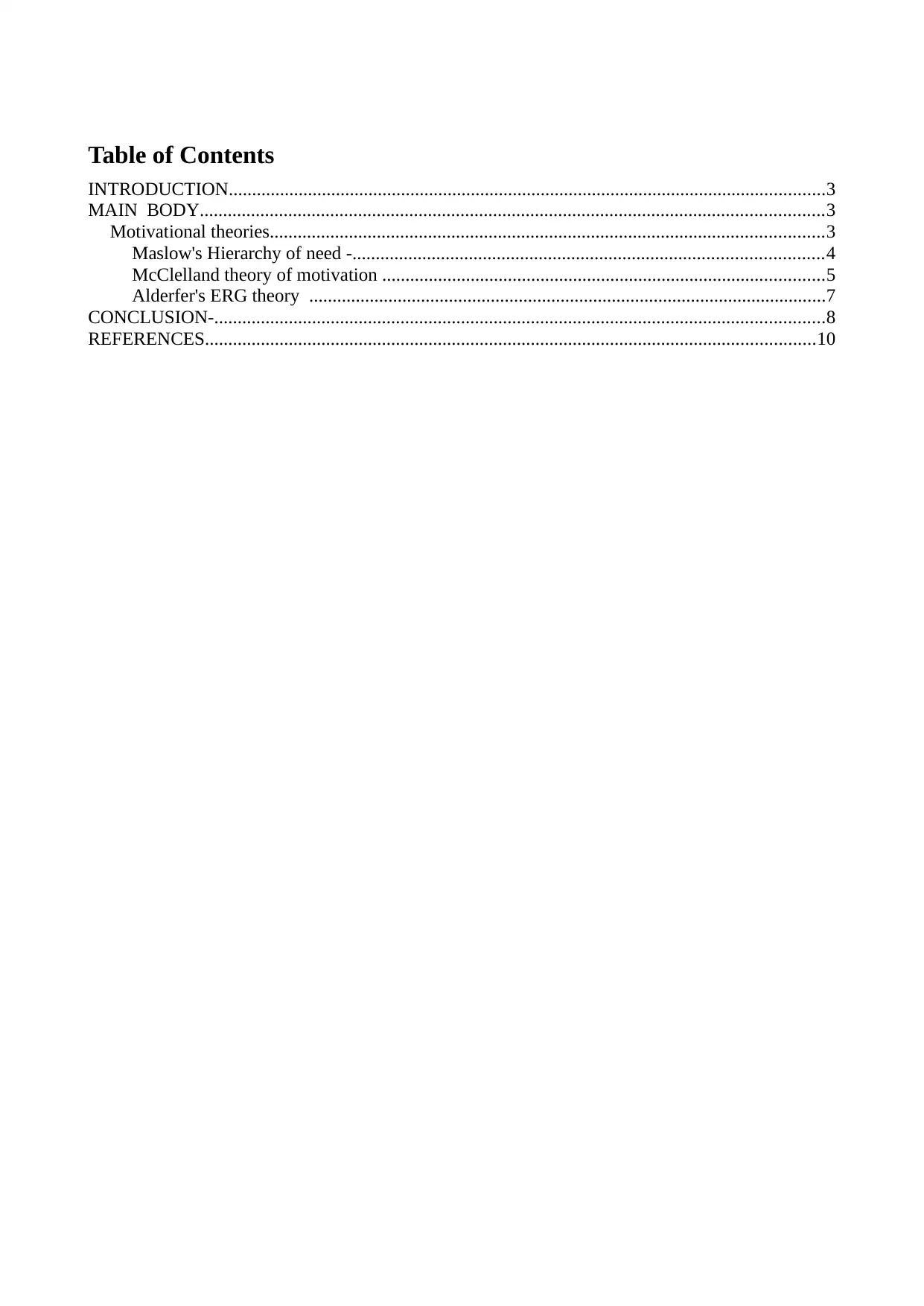
Table of Contents
INTRODUCTION................................................................................................................................3
MAIN BODY......................................................................................................................................3
Motivational theories.......................................................................................................................3
Maslow's Hierarchy of need -.....................................................................................................4
McClelland theory of motivation ...............................................................................................5
Alderfer's ERG theory ...............................................................................................................7
CONCLUSION-...................................................................................................................................8
REFERENCES...................................................................................................................................10
INTRODUCTION................................................................................................................................3
MAIN BODY......................................................................................................................................3
Motivational theories.......................................................................................................................3
Maslow's Hierarchy of need -.....................................................................................................4
McClelland theory of motivation ...............................................................................................5
Alderfer's ERG theory ...............................................................................................................7
CONCLUSION-...................................................................................................................................8
REFERENCES...................................................................................................................................10
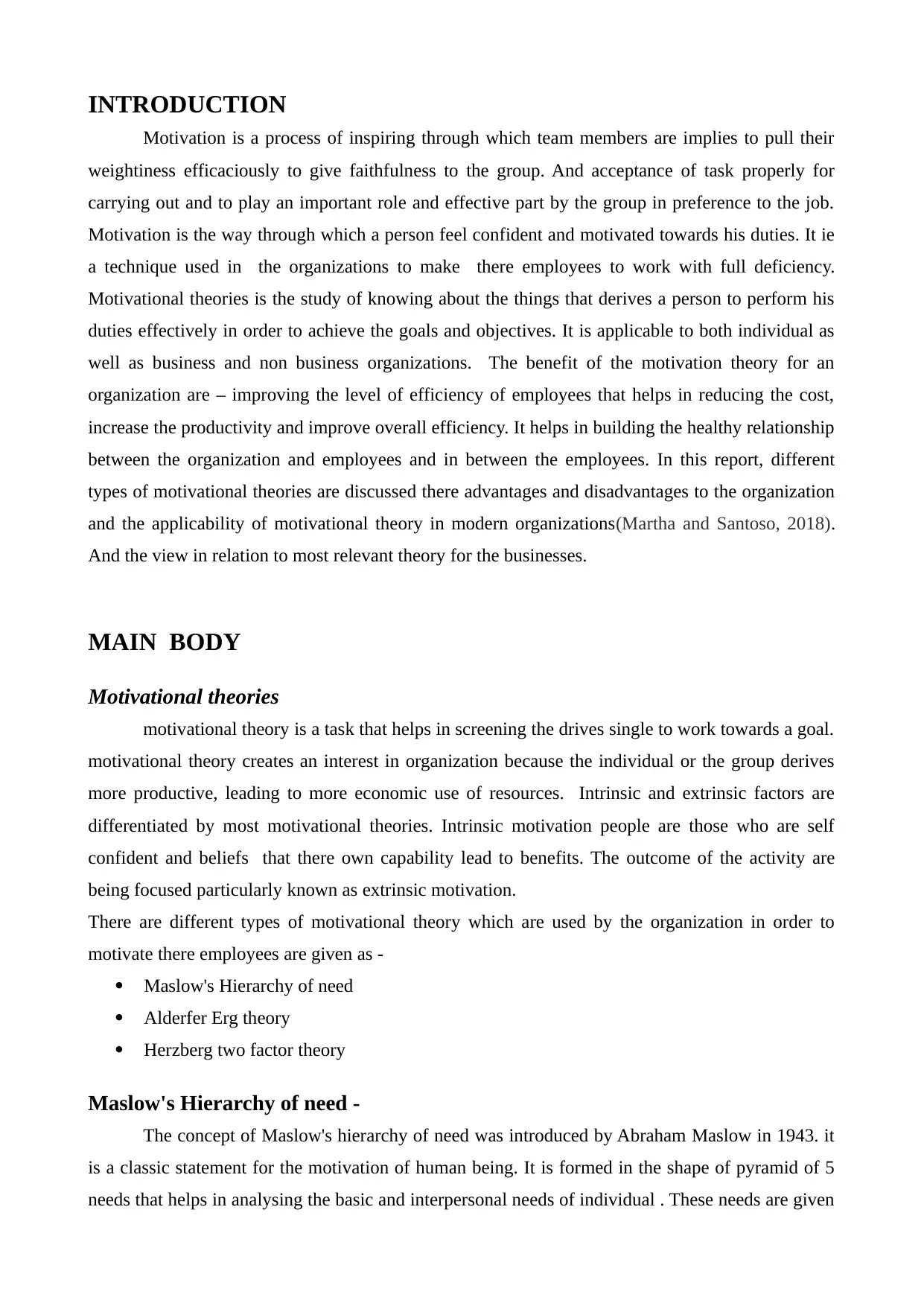
INTRODUCTION
Motivation is a process of inspiring through which team members are implies to pull their
weightiness efficaciously to give faithfulness to the group. And acceptance of task properly for
carrying out and to play an important role and effective part by the group in preference to the job.
Motivation is the way through which a person feel confident and motivated towards his duties. It ie
a technique used in the organizations to make there employees to work with full deficiency.
Motivational theories is the study of knowing about the things that derives a person to perform his
duties effectively in order to achieve the goals and objectives. It is applicable to both individual as
well as business and non business organizations. The benefit of the motivation theory for an
organization are – improving the level of efficiency of employees that helps in reducing the cost,
increase the productivity and improve overall efficiency. It helps in building the healthy relationship
between the organization and employees and in between the employees. In this report, different
types of motivational theories are discussed there advantages and disadvantages to the organization
and the applicability of motivational theory in modern organizations(Martha and Santoso, 2018).
And the view in relation to most relevant theory for the businesses.
MAIN BODY
Motivational theories
motivational theory is a task that helps in screening the drives single to work towards a goal.
motivational theory creates an interest in organization because the individual or the group derives
more productive, leading to more economic use of resources. Intrinsic and extrinsic factors are
differentiated by most motivational theories. Intrinsic motivation people are those who are self
confident and beliefs that there own capability lead to benefits. The outcome of the activity are
being focused particularly known as extrinsic motivation.
There are different types of motivational theory which are used by the organization in order to
motivate there employees are given as -
Maslow's Hierarchy of need
Alderfer Erg theory
Herzberg two factor theory
Maslow's Hierarchy of need -
The concept of Maslow's hierarchy of need was introduced by Abraham Maslow in 1943. it
is a classic statement for the motivation of human being. It is formed in the shape of pyramid of 5
needs that helps in analysing the basic and interpersonal needs of individual . These needs are given
Motivation is a process of inspiring through which team members are implies to pull their
weightiness efficaciously to give faithfulness to the group. And acceptance of task properly for
carrying out and to play an important role and effective part by the group in preference to the job.
Motivation is the way through which a person feel confident and motivated towards his duties. It ie
a technique used in the organizations to make there employees to work with full deficiency.
Motivational theories is the study of knowing about the things that derives a person to perform his
duties effectively in order to achieve the goals and objectives. It is applicable to both individual as
well as business and non business organizations. The benefit of the motivation theory for an
organization are – improving the level of efficiency of employees that helps in reducing the cost,
increase the productivity and improve overall efficiency. It helps in building the healthy relationship
between the organization and employees and in between the employees. In this report, different
types of motivational theories are discussed there advantages and disadvantages to the organization
and the applicability of motivational theory in modern organizations(Martha and Santoso, 2018).
And the view in relation to most relevant theory for the businesses.
MAIN BODY
Motivational theories
motivational theory is a task that helps in screening the drives single to work towards a goal.
motivational theory creates an interest in organization because the individual or the group derives
more productive, leading to more economic use of resources. Intrinsic and extrinsic factors are
differentiated by most motivational theories. Intrinsic motivation people are those who are self
confident and beliefs that there own capability lead to benefits. The outcome of the activity are
being focused particularly known as extrinsic motivation.
There are different types of motivational theory which are used by the organization in order to
motivate there employees are given as -
Maslow's Hierarchy of need
Alderfer Erg theory
Herzberg two factor theory
Maslow's Hierarchy of need -
The concept of Maslow's hierarchy of need was introduced by Abraham Maslow in 1943. it
is a classic statement for the motivation of human being. It is formed in the shape of pyramid of 5
needs that helps in analysing the basic and interpersonal needs of individual . These needs are given
⊘ This is a preview!⊘
Do you want full access?
Subscribe today to unlock all pages.

Trusted by 1+ million students worldwide
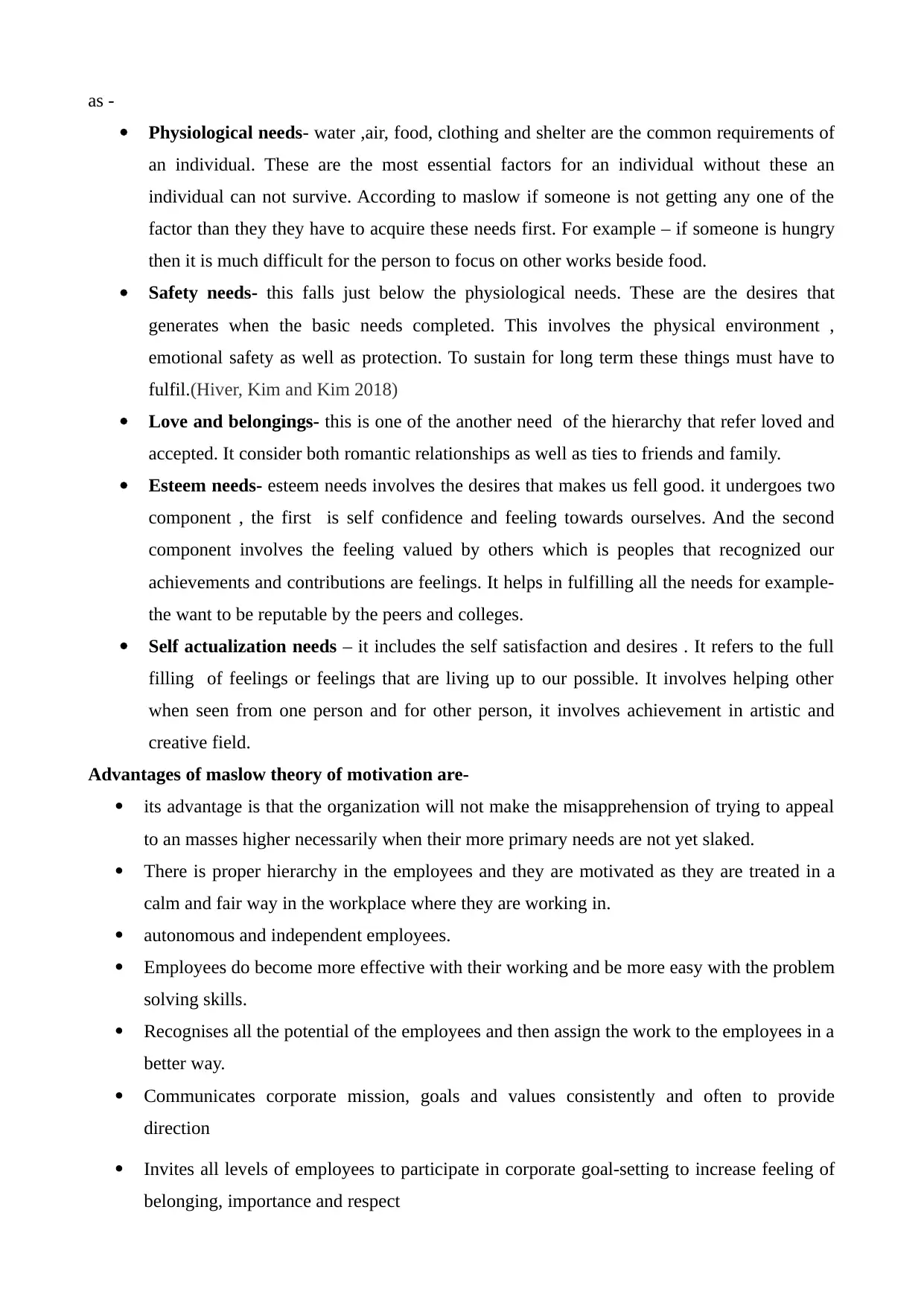
as -
Physiological needs- water ,air, food, clothing and shelter are the common requirements of
an individual. These are the most essential factors for an individual without these an
individual can not survive. According to maslow if someone is not getting any one of the
factor than they they have to acquire these needs first. For example – if someone is hungry
then it is much difficult for the person to focus on other works beside food.
Safety needs- this falls just below the physiological needs. These are the desires that
generates when the basic needs completed. This involves the physical environment ,
emotional safety as well as protection. To sustain for long term these things must have to
fulfil.(Hiver, Kim and Kim 2018)
Love and belongings- this is one of the another need of the hierarchy that refer loved and
accepted. It consider both romantic relationships as well as ties to friends and family.
Esteem needs- esteem needs involves the desires that makes us fell good. it undergoes two
component , the first is self confidence and feeling towards ourselves. And the second
component involves the feeling valued by others which is peoples that recognized our
achievements and contributions are feelings. It helps in fulfilling all the needs for example-
the want to be reputable by the peers and colleges.
Self actualization needs – it includes the self satisfaction and desires . It refers to the full
filling of feelings or feelings that are living up to our possible. It involves helping other
when seen from one person and for other person, it involves achievement in artistic and
creative field.
Advantages of maslow theory of motivation are-
its advantage is that the organization will not make the misapprehension of trying to appeal
to an masses higher necessarily when their more primary needs are not yet slaked.
There is proper hierarchy in the employees and they are motivated as they are treated in a
calm and fair way in the workplace where they are working in.
autonomous and independent employees.
Employees do become more effective with their working and be more easy with the problem
solving skills.
Recognises all the potential of the employees and then assign the work to the employees in a
better way.
Communicates corporate mission, goals and values consistently and often to provide
direction
Invites all levels of employees to participate in corporate goal-setting to increase feeling of
belonging, importance and respect
Physiological needs- water ,air, food, clothing and shelter are the common requirements of
an individual. These are the most essential factors for an individual without these an
individual can not survive. According to maslow if someone is not getting any one of the
factor than they they have to acquire these needs first. For example – if someone is hungry
then it is much difficult for the person to focus on other works beside food.
Safety needs- this falls just below the physiological needs. These are the desires that
generates when the basic needs completed. This involves the physical environment ,
emotional safety as well as protection. To sustain for long term these things must have to
fulfil.(Hiver, Kim and Kim 2018)
Love and belongings- this is one of the another need of the hierarchy that refer loved and
accepted. It consider both romantic relationships as well as ties to friends and family.
Esteem needs- esteem needs involves the desires that makes us fell good. it undergoes two
component , the first is self confidence and feeling towards ourselves. And the second
component involves the feeling valued by others which is peoples that recognized our
achievements and contributions are feelings. It helps in fulfilling all the needs for example-
the want to be reputable by the peers and colleges.
Self actualization needs – it includes the self satisfaction and desires . It refers to the full
filling of feelings or feelings that are living up to our possible. It involves helping other
when seen from one person and for other person, it involves achievement in artistic and
creative field.
Advantages of maslow theory of motivation are-
its advantage is that the organization will not make the misapprehension of trying to appeal
to an masses higher necessarily when their more primary needs are not yet slaked.
There is proper hierarchy in the employees and they are motivated as they are treated in a
calm and fair way in the workplace where they are working in.
autonomous and independent employees.
Employees do become more effective with their working and be more easy with the problem
solving skills.
Recognises all the potential of the employees and then assign the work to the employees in a
better way.
Communicates corporate mission, goals and values consistently and often to provide
direction
Invites all levels of employees to participate in corporate goal-setting to increase feeling of
belonging, importance and respect
Paraphrase This Document
Need a fresh take? Get an instant paraphrase of this document with our AI Paraphraser
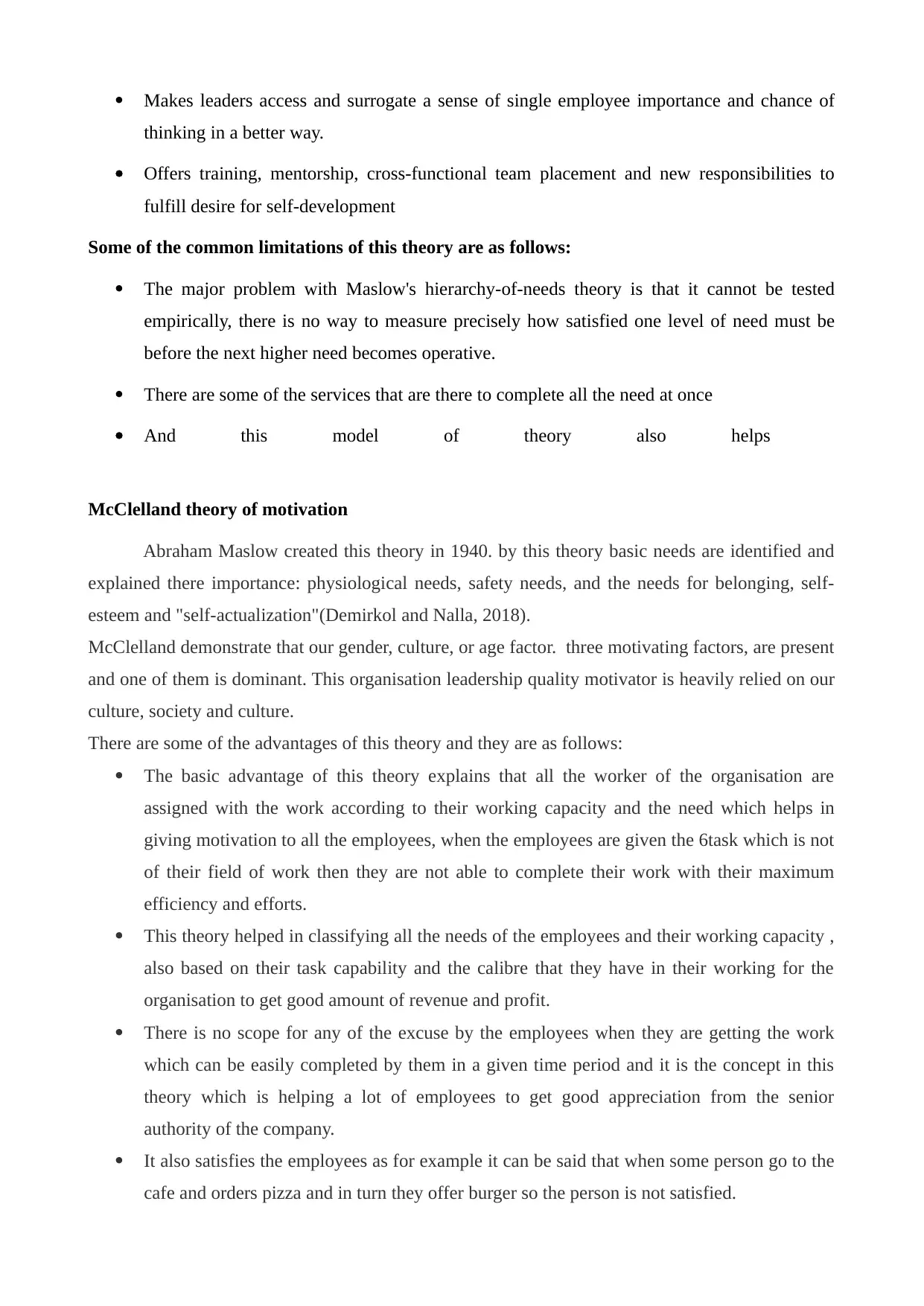
Makes leaders access and surrogate a sense of single employee importance and chance of
thinking in a better way.
Offers training, mentorship, cross-functional team placement and new responsibilities to
fulfill desire for self-development
Some of the common limitations of this theory are as follows:
The major problem with Maslow's hierarchy-of-needs theory is that it cannot be tested
empirically, there is no way to measure precisely how satisfied one level of need must be
before the next higher need becomes operative.
There are some of the services that are there to complete all the need at once
And this model of theory also helps
McClelland theory of motivation
Abraham Maslow created this theory in 1940. by this theory basic needs are identified and
explained there importance: physiological needs, safety needs, and the needs for belonging, self-
esteem and "self-actualization"(Demirkol and Nalla, 2018).
McClelland demonstrate that our gender, culture, or age factor. three motivating factors, are present
and one of them is dominant. This organisation leadership quality motivator is heavily relied on our
culture, society and culture.
There are some of the advantages of this theory and they are as follows:
The basic advantage of this theory explains that all the worker of the organisation are
assigned with the work according to their working capacity and the need which helps in
giving motivation to all the employees, when the employees are given the 6task which is not
of their field of work then they are not able to complete their work with their maximum
efficiency and efforts.
This theory helped in classifying all the needs of the employees and their working capacity ,
also based on their task capability and the calibre that they have in their working for the
organisation to get good amount of revenue and profit.
There is no scope for any of the excuse by the employees when they are getting the work
which can be easily completed by them in a given time period and it is the concept in this
theory which is helping a lot of employees to get good appreciation from the senior
authority of the company.
It also satisfies the employees as for example it can be said that when some person go to the
cafe and orders pizza and in turn they offer burger so the person is not satisfied.
thinking in a better way.
Offers training, mentorship, cross-functional team placement and new responsibilities to
fulfill desire for self-development
Some of the common limitations of this theory are as follows:
The major problem with Maslow's hierarchy-of-needs theory is that it cannot be tested
empirically, there is no way to measure precisely how satisfied one level of need must be
before the next higher need becomes operative.
There are some of the services that are there to complete all the need at once
And this model of theory also helps
McClelland theory of motivation
Abraham Maslow created this theory in 1940. by this theory basic needs are identified and
explained there importance: physiological needs, safety needs, and the needs for belonging, self-
esteem and "self-actualization"(Demirkol and Nalla, 2018).
McClelland demonstrate that our gender, culture, or age factor. three motivating factors, are present
and one of them is dominant. This organisation leadership quality motivator is heavily relied on our
culture, society and culture.
There are some of the advantages of this theory and they are as follows:
The basic advantage of this theory explains that all the worker of the organisation are
assigned with the work according to their working capacity and the need which helps in
giving motivation to all the employees, when the employees are given the 6task which is not
of their field of work then they are not able to complete their work with their maximum
efficiency and efforts.
This theory helped in classifying all the needs of the employees and their working capacity ,
also based on their task capability and the calibre that they have in their working for the
organisation to get good amount of revenue and profit.
There is no scope for any of the excuse by the employees when they are getting the work
which can be easily completed by them in a given time period and it is the concept in this
theory which is helping a lot of employees to get good appreciation from the senior
authority of the company.
It also satisfies the employees as for example it can be said that when some person go to the
cafe and orders pizza and in turn they offer burger so the person is not satisfied.
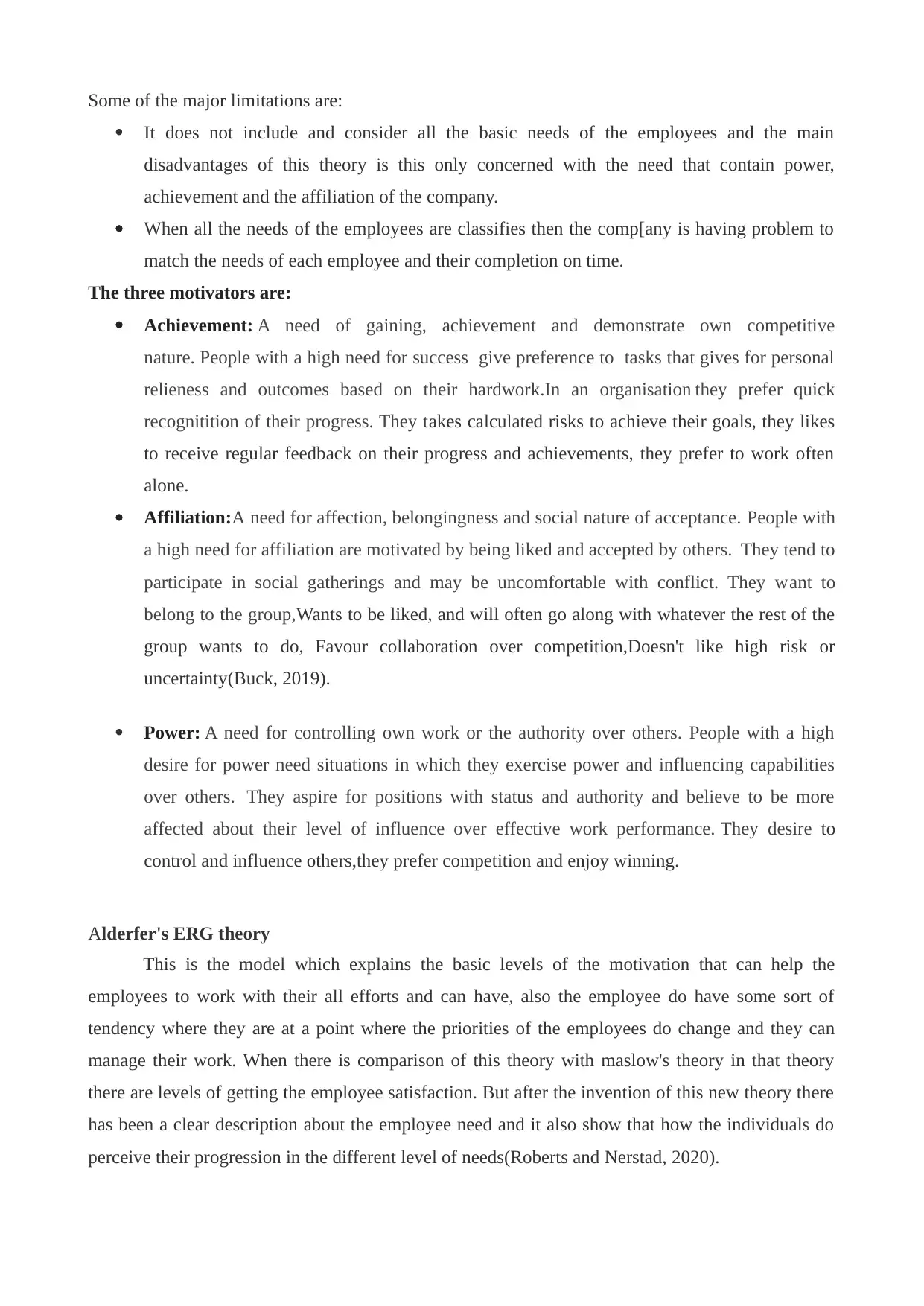
Some of the major limitations are:
It does not include and consider all the basic needs of the employees and the main
disadvantages of this theory is this only concerned with the need that contain power,
achievement and the affiliation of the company.
When all the needs of the employees are classifies then the comp[any is having problem to
match the needs of each employee and their completion on time.
The three motivators are:
Achievement: A need of gaining, achievement and demonstrate own competitive
nature. People with a high need for success give preference to tasks that gives for personal
relieness and outcomes based on their hardwork.In an organisation they prefer quick
recognitition of their progress. They takes calculated risks to achieve their goals, they likes
to receive regular feedback on their progress and achievements, they prefer to work often
alone.
Affiliation:A need for affection, belongingness and social nature of acceptance. People with
a high need for affiliation are motivated by being liked and accepted by others. They tend to
participate in social gatherings and may be uncomfortable with conflict. They want to
belong to the group,Wants to be liked, and will often go along with whatever the rest of the
group wants to do, Favour collaboration over competition,Doesn't like high risk or
uncertainty(Buck, 2019).
Power: A need for controlling own work or the authority over others. People with a high
desire for power need situations in which they exercise power and influencing capabilities
over others. They aspire for positions with status and authority and believe to be more
affected about their level of influence over effective work performance. They desire to
control and influence others,they prefer competition and enjoy winning.
Alderfer's ERG theory
This is the model which explains the basic levels of the motivation that can help the
employees to work with their all efforts and can have, also the employee do have some sort of
tendency where they are at a point where the priorities of the employees do change and they can
manage their work. When there is comparison of this theory with maslow's theory in that theory
there are levels of getting the employee satisfaction. But after the invention of this new theory there
has been a clear description about the employee need and it also show that how the individuals do
perceive their progression in the different level of needs(Roberts and Nerstad, 2020).
It does not include and consider all the basic needs of the employees and the main
disadvantages of this theory is this only concerned with the need that contain power,
achievement and the affiliation of the company.
When all the needs of the employees are classifies then the comp[any is having problem to
match the needs of each employee and their completion on time.
The three motivators are:
Achievement: A need of gaining, achievement and demonstrate own competitive
nature. People with a high need for success give preference to tasks that gives for personal
relieness and outcomes based on their hardwork.In an organisation they prefer quick
recognitition of their progress. They takes calculated risks to achieve their goals, they likes
to receive regular feedback on their progress and achievements, they prefer to work often
alone.
Affiliation:A need for affection, belongingness and social nature of acceptance. People with
a high need for affiliation are motivated by being liked and accepted by others. They tend to
participate in social gatherings and may be uncomfortable with conflict. They want to
belong to the group,Wants to be liked, and will often go along with whatever the rest of the
group wants to do, Favour collaboration over competition,Doesn't like high risk or
uncertainty(Buck, 2019).
Power: A need for controlling own work or the authority over others. People with a high
desire for power need situations in which they exercise power and influencing capabilities
over others. They aspire for positions with status and authority and believe to be more
affected about their level of influence over effective work performance. They desire to
control and influence others,they prefer competition and enjoy winning.
Alderfer's ERG theory
This is the model which explains the basic levels of the motivation that can help the
employees to work with their all efforts and can have, also the employee do have some sort of
tendency where they are at a point where the priorities of the employees do change and they can
manage their work. When there is comparison of this theory with maslow's theory in that theory
there are levels of getting the employee satisfaction. But after the invention of this new theory there
has been a clear description about the employee need and it also show that how the individuals do
perceive their progression in the different level of needs(Roberts and Nerstad, 2020).
⊘ This is a preview!⊘
Do you want full access?
Subscribe today to unlock all pages.

Trusted by 1+ million students worldwide
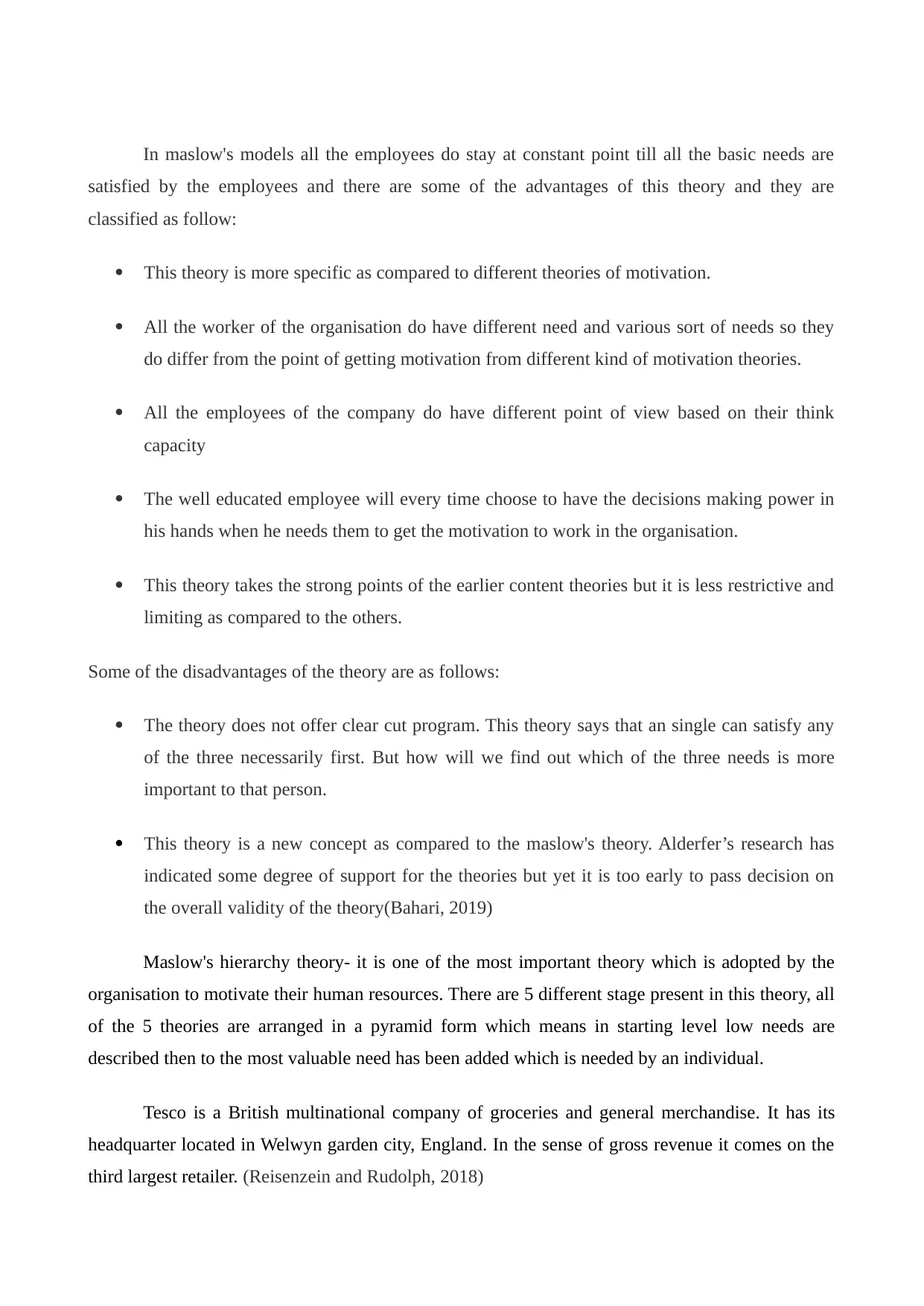
In maslow's models all the employees do stay at constant point till all the basic needs are
satisfied by the employees and there are some of the advantages of this theory and they are
classified as follow:
This theory is more specific as compared to different theories of motivation.
All the worker of the organisation do have different need and various sort of needs so they
do differ from the point of getting motivation from different kind of motivation theories.
All the employees of the company do have different point of view based on their think
capacity
The well educated employee will every time choose to have the decisions making power in
his hands when he needs them to get the motivation to work in the organisation.
This theory takes the strong points of the earlier content theories but it is less restrictive and
limiting as compared to the others.
Some of the disadvantages of the theory are as follows:
The theory does not offer clear cut program. This theory says that an single can satisfy any
of the three necessarily first. But how will we find out which of the three needs is more
important to that person.
This theory is a new concept as compared to the maslow's theory. Alderfer’s research has
indicated some degree of support for the theories but yet it is too early to pass decision on
the overall validity of the theory(Bahari, 2019)
Maslow's hierarchy theory- it is one of the most important theory which is adopted by the
organisation to motivate their human resources. There are 5 different stage present in this theory, all
of the 5 theories are arranged in a pyramid form which means in starting level low needs are
described then to the most valuable need has been added which is needed by an individual.
Tesco is a British multinational company of groceries and general merchandise. It has its
headquarter located in Welwyn garden city, England. In the sense of gross revenue it comes on the
third largest retailer. (Reisenzein and Rudolph, 2018)
satisfied by the employees and there are some of the advantages of this theory and they are
classified as follow:
This theory is more specific as compared to different theories of motivation.
All the worker of the organisation do have different need and various sort of needs so they
do differ from the point of getting motivation from different kind of motivation theories.
All the employees of the company do have different point of view based on their think
capacity
The well educated employee will every time choose to have the decisions making power in
his hands when he needs them to get the motivation to work in the organisation.
This theory takes the strong points of the earlier content theories but it is less restrictive and
limiting as compared to the others.
Some of the disadvantages of the theory are as follows:
The theory does not offer clear cut program. This theory says that an single can satisfy any
of the three necessarily first. But how will we find out which of the three needs is more
important to that person.
This theory is a new concept as compared to the maslow's theory. Alderfer’s research has
indicated some degree of support for the theories but yet it is too early to pass decision on
the overall validity of the theory(Bahari, 2019)
Maslow's hierarchy theory- it is one of the most important theory which is adopted by the
organisation to motivate their human resources. There are 5 different stage present in this theory, all
of the 5 theories are arranged in a pyramid form which means in starting level low needs are
described then to the most valuable need has been added which is needed by an individual.
Tesco is a British multinational company of groceries and general merchandise. It has its
headquarter located in Welwyn garden city, England. In the sense of gross revenue it comes on the
third largest retailer. (Reisenzein and Rudolph, 2018)
Paraphrase This Document
Need a fresh take? Get an instant paraphrase of this document with our AI Paraphraser
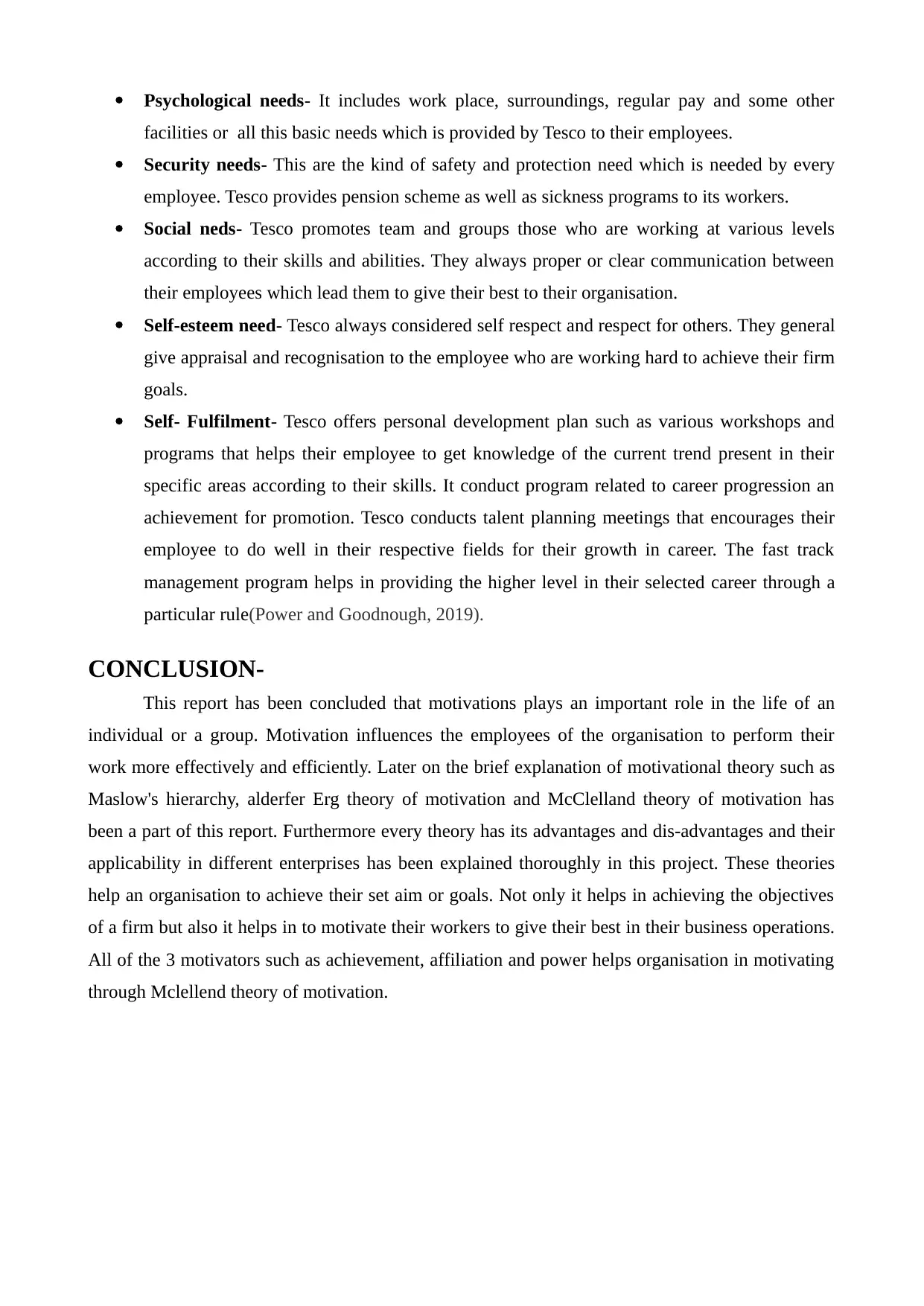
Psychological needs- It includes work place, surroundings, regular pay and some other
facilities or all this basic needs which is provided by Tesco to their employees.
Security needs- This are the kind of safety and protection need which is needed by every
employee. Tesco provides pension scheme as well as sickness programs to its workers.
Social neds- Tesco promotes team and groups those who are working at various levels
according to their skills and abilities. They always proper or clear communication between
their employees which lead them to give their best to their organisation.
Self-esteem need- Tesco always considered self respect and respect for others. They general
give appraisal and recognisation to the employee who are working hard to achieve their firm
goals.
Self- Fulfilment- Tesco offers personal development plan such as various workshops and
programs that helps their employee to get knowledge of the current trend present in their
specific areas according to their skills. It conduct program related to career progression an
achievement for promotion. Tesco conducts talent planning meetings that encourages their
employee to do well in their respective fields for their growth in career. The fast track
management program helps in providing the higher level in their selected career through a
particular rule(Power and Goodnough, 2019).
CONCLUSION-
This report has been concluded that motivations plays an important role in the life of an
individual or a group. Motivation influences the employees of the organisation to perform their
work more effectively and efficiently. Later on the brief explanation of motivational theory such as
Maslow's hierarchy, alderfer Erg theory of motivation and McClelland theory of motivation has
been a part of this report. Furthermore every theory has its advantages and dis-advantages and their
applicability in different enterprises has been explained thoroughly in this project. These theories
help an organisation to achieve their set aim or goals. Not only it helps in achieving the objectives
of a firm but also it helps in to motivate their workers to give their best in their business operations.
All of the 3 motivators such as achievement, affiliation and power helps organisation in motivating
through Mclellend theory of motivation.
facilities or all this basic needs which is provided by Tesco to their employees.
Security needs- This are the kind of safety and protection need which is needed by every
employee. Tesco provides pension scheme as well as sickness programs to its workers.
Social neds- Tesco promotes team and groups those who are working at various levels
according to their skills and abilities. They always proper or clear communication between
their employees which lead them to give their best to their organisation.
Self-esteem need- Tesco always considered self respect and respect for others. They general
give appraisal and recognisation to the employee who are working hard to achieve their firm
goals.
Self- Fulfilment- Tesco offers personal development plan such as various workshops and
programs that helps their employee to get knowledge of the current trend present in their
specific areas according to their skills. It conduct program related to career progression an
achievement for promotion. Tesco conducts talent planning meetings that encourages their
employee to do well in their respective fields for their growth in career. The fast track
management program helps in providing the higher level in their selected career through a
particular rule(Power and Goodnough, 2019).
CONCLUSION-
This report has been concluded that motivations plays an important role in the life of an
individual or a group. Motivation influences the employees of the organisation to perform their
work more effectively and efficiently. Later on the brief explanation of motivational theory such as
Maslow's hierarchy, alderfer Erg theory of motivation and McClelland theory of motivation has
been a part of this report. Furthermore every theory has its advantages and dis-advantages and their
applicability in different enterprises has been explained thoroughly in this project. These theories
help an organisation to achieve their set aim or goals. Not only it helps in achieving the objectives
of a firm but also it helps in to motivate their workers to give their best in their business operations.
All of the 3 motivators such as achievement, affiliation and power helps organisation in motivating
through Mclellend theory of motivation.
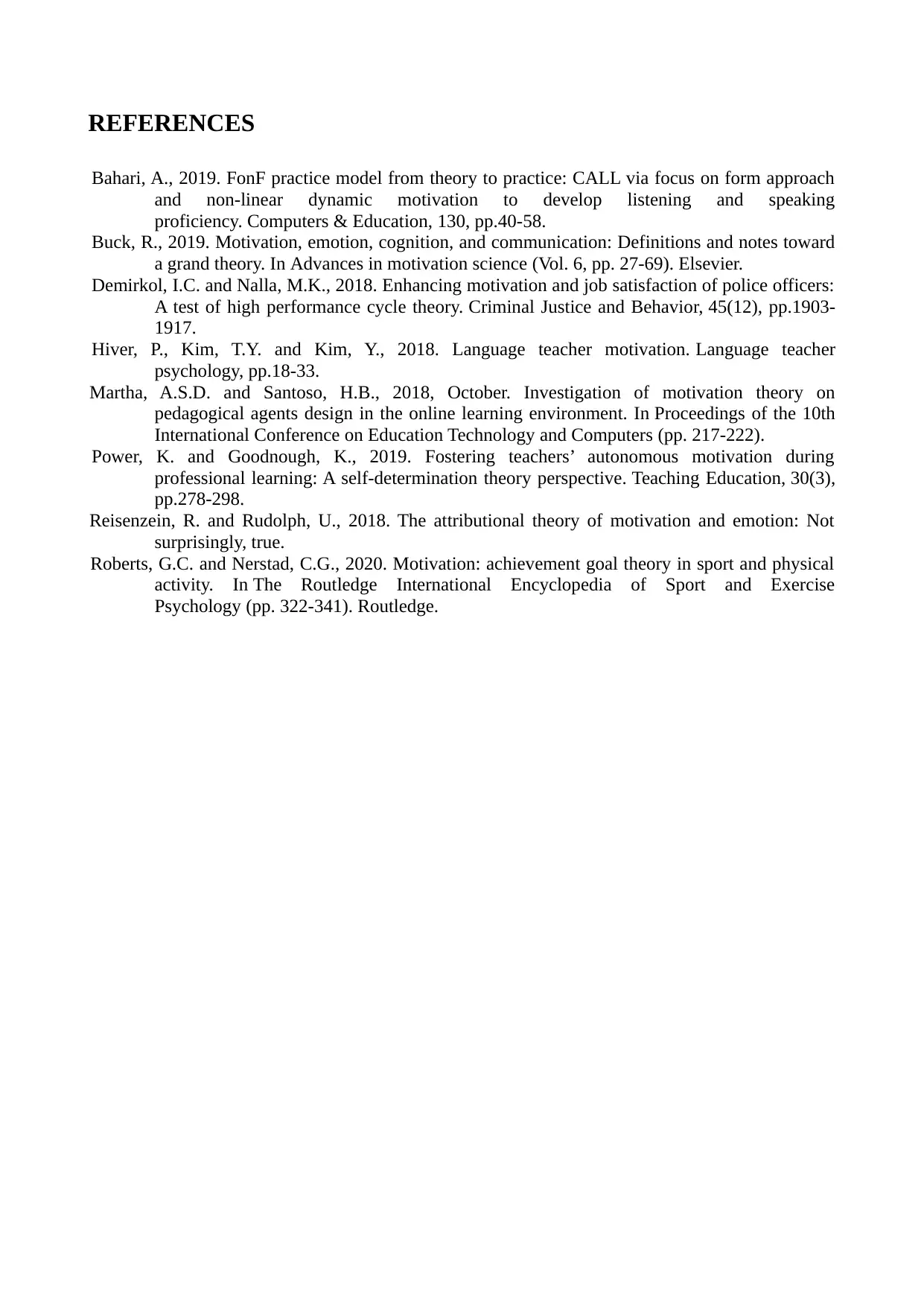
REFERENCES
Bahari, A., 2019. FonF practice model from theory to practice: CALL via focus on form approach
and non-linear dynamic motivation to develop listening and speaking
proficiency. Computers & Education, 130, pp.40-58.
Buck, R., 2019. Motivation, emotion, cognition, and communication: Definitions and notes toward
a grand theory. In Advances in motivation science (Vol. 6, pp. 27-69). Elsevier.
Demirkol, I.C. and Nalla, M.K., 2018. Enhancing motivation and job satisfaction of police officers:
A test of high performance cycle theory. Criminal Justice and Behavior, 45(12), pp.1903-
1917.
Hiver, P., Kim, T.Y. and Kim, Y., 2018. Language teacher motivation. Language teacher
psychology, pp.18-33.
Martha, A.S.D. and Santoso, H.B., 2018, October. Investigation of motivation theory on
pedagogical agents design in the online learning environment. In Proceedings of the 10th
International Conference on Education Technology and Computers (pp. 217-222).
Power, K. and Goodnough, K., 2019. Fostering teachers’ autonomous motivation during
professional learning: A self-determination theory perspective. Teaching Education, 30(3),
pp.278-298.
Reisenzein, R. and Rudolph, U., 2018. The attributional theory of motivation and emotion: Not
surprisingly, true.
Roberts, G.C. and Nerstad, C.G., 2020. Motivation: achievement goal theory in sport and physical
activity. In The Routledge International Encyclopedia of Sport and Exercise
Psychology (pp. 322-341). Routledge.
Bahari, A., 2019. FonF practice model from theory to practice: CALL via focus on form approach
and non-linear dynamic motivation to develop listening and speaking
proficiency. Computers & Education, 130, pp.40-58.
Buck, R., 2019. Motivation, emotion, cognition, and communication: Definitions and notes toward
a grand theory. In Advances in motivation science (Vol. 6, pp. 27-69). Elsevier.
Demirkol, I.C. and Nalla, M.K., 2018. Enhancing motivation and job satisfaction of police officers:
A test of high performance cycle theory. Criminal Justice and Behavior, 45(12), pp.1903-
1917.
Hiver, P., Kim, T.Y. and Kim, Y., 2018. Language teacher motivation. Language teacher
psychology, pp.18-33.
Martha, A.S.D. and Santoso, H.B., 2018, October. Investigation of motivation theory on
pedagogical agents design in the online learning environment. In Proceedings of the 10th
International Conference on Education Technology and Computers (pp. 217-222).
Power, K. and Goodnough, K., 2019. Fostering teachers’ autonomous motivation during
professional learning: A self-determination theory perspective. Teaching Education, 30(3),
pp.278-298.
Reisenzein, R. and Rudolph, U., 2018. The attributional theory of motivation and emotion: Not
surprisingly, true.
Roberts, G.C. and Nerstad, C.G., 2020. Motivation: achievement goal theory in sport and physical
activity. In The Routledge International Encyclopedia of Sport and Exercise
Psychology (pp. 322-341). Routledge.
⊘ This is a preview!⊘
Do you want full access?
Subscribe today to unlock all pages.

Trusted by 1+ million students worldwide
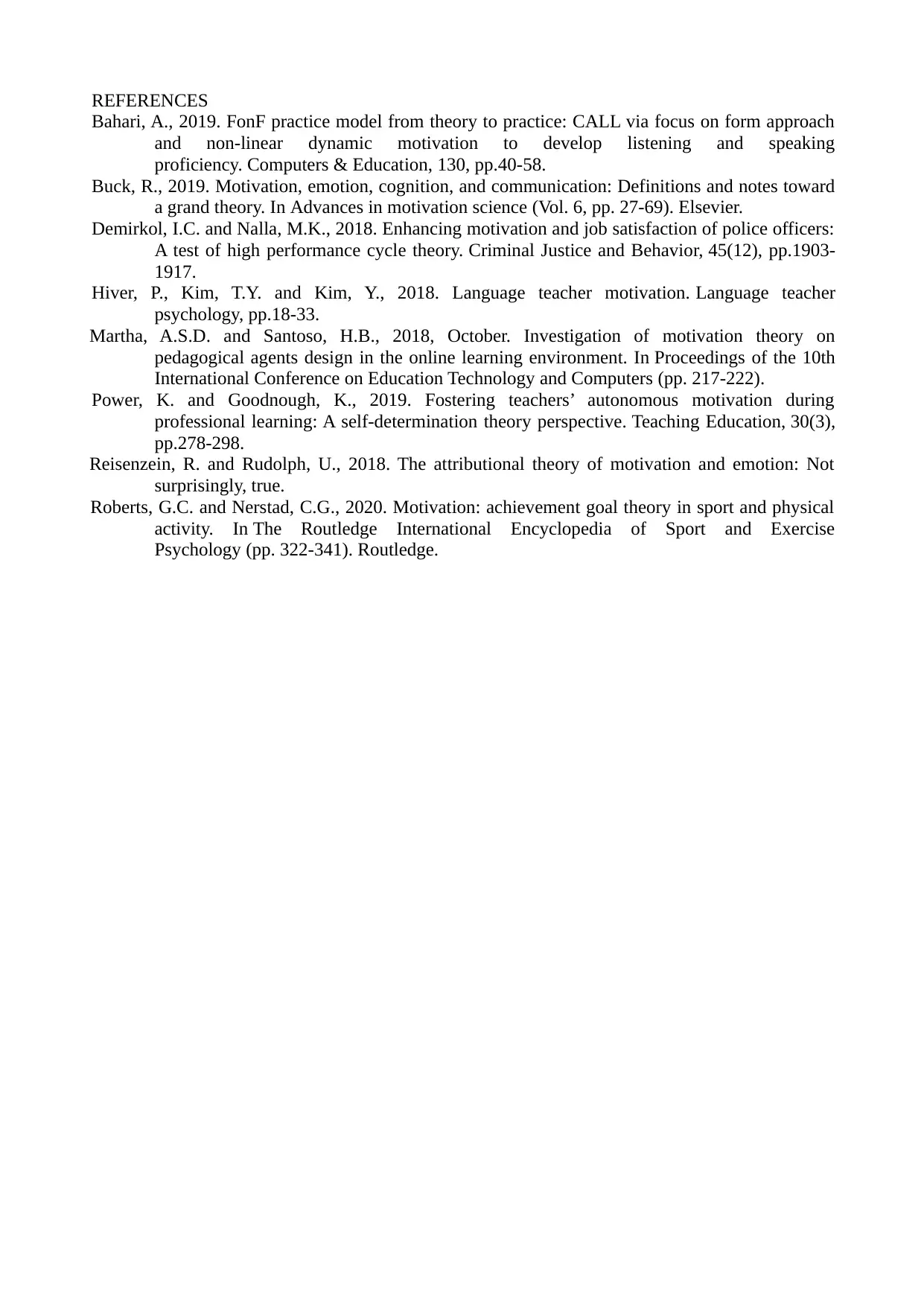
REFERENCES
Bahari, A., 2019. FonF practice model from theory to practice: CALL via focus on form approach
and non-linear dynamic motivation to develop listening and speaking
proficiency. Computers & Education, 130, pp.40-58.
Buck, R., 2019. Motivation, emotion, cognition, and communication: Definitions and notes toward
a grand theory. In Advances in motivation science (Vol. 6, pp. 27-69). Elsevier.
Demirkol, I.C. and Nalla, M.K., 2018. Enhancing motivation and job satisfaction of police officers:
A test of high performance cycle theory. Criminal Justice and Behavior, 45(12), pp.1903-
1917.
Hiver, P., Kim, T.Y. and Kim, Y., 2018. Language teacher motivation. Language teacher
psychology, pp.18-33.
Martha, A.S.D. and Santoso, H.B., 2018, October. Investigation of motivation theory on
pedagogical agents design in the online learning environment. In Proceedings of the 10th
International Conference on Education Technology and Computers (pp. 217-222).
Power, K. and Goodnough, K., 2019. Fostering teachers’ autonomous motivation during
professional learning: A self-determination theory perspective. Teaching Education, 30(3),
pp.278-298.
Reisenzein, R. and Rudolph, U., 2018. The attributional theory of motivation and emotion: Not
surprisingly, true.
Roberts, G.C. and Nerstad, C.G., 2020. Motivation: achievement goal theory in sport and physical
activity. In The Routledge International Encyclopedia of Sport and Exercise
Psychology (pp. 322-341). Routledge.
Bahari, A., 2019. FonF practice model from theory to practice: CALL via focus on form approach
and non-linear dynamic motivation to develop listening and speaking
proficiency. Computers & Education, 130, pp.40-58.
Buck, R., 2019. Motivation, emotion, cognition, and communication: Definitions and notes toward
a grand theory. In Advances in motivation science (Vol. 6, pp. 27-69). Elsevier.
Demirkol, I.C. and Nalla, M.K., 2018. Enhancing motivation and job satisfaction of police officers:
A test of high performance cycle theory. Criminal Justice and Behavior, 45(12), pp.1903-
1917.
Hiver, P., Kim, T.Y. and Kim, Y., 2018. Language teacher motivation. Language teacher
psychology, pp.18-33.
Martha, A.S.D. and Santoso, H.B., 2018, October. Investigation of motivation theory on
pedagogical agents design in the online learning environment. In Proceedings of the 10th
International Conference on Education Technology and Computers (pp. 217-222).
Power, K. and Goodnough, K., 2019. Fostering teachers’ autonomous motivation during
professional learning: A self-determination theory perspective. Teaching Education, 30(3),
pp.278-298.
Reisenzein, R. and Rudolph, U., 2018. The attributional theory of motivation and emotion: Not
surprisingly, true.
Roberts, G.C. and Nerstad, C.G., 2020. Motivation: achievement goal theory in sport and physical
activity. In The Routledge International Encyclopedia of Sport and Exercise
Psychology (pp. 322-341). Routledge.
1 out of 10
Related Documents
Your All-in-One AI-Powered Toolkit for Academic Success.
+13062052269
info@desklib.com
Available 24*7 on WhatsApp / Email
![[object Object]](/_next/static/media/star-bottom.7253800d.svg)
Unlock your academic potential
Copyright © 2020–2025 A2Z Services. All Rights Reserved. Developed and managed by ZUCOL.




